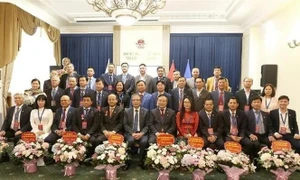This is Vietnam’s sectoral plan that goes into detail on managing and developing urban and rural systems, based on the national master plan.
A network of urban and rural areas is expected to take shape through sectoral and regional connections in regard to infrastructure, resource use, environment protection and biodiversity conservation.

A new-style rural area in the northern province of Thai Nguyen (Photo: VNA)
The plan for 2021-2030 with a vision to 2050, stresses urban development as a growth driver and a key element of economic growth, while rural areas play a fundamental role in sustainable urban development.
The Ministry of Construction (MoC) will document the political, legal and scientific basis for this plan as well as its impact in relation to other sectoral, provincial and national planning.
According to construction minister Nguyen Tuong Van, this is the first time that the plan for urban and rural systems is built based on the Law on Planning.
This plan aims to connect urban and rural spaces to the national socio-economic development zones and regions with specific focuses, while effectively linking to the infrastructure system.
Urban systems are expected to be developed in different lines and clusters, concentrating on several areas that enjoy favourable geographical, socio-economic infrastructure and a good available workforce.
These advantages will turn them into key regions and economic corridors for growth, thereby impacting other small and medium-sized urban areas and accelerating the urbanisation of rural zones.
The plan also aims to reduce urban development gaps by supporting rural areas through small-scale urban zones and suburbs, while strengthening the linkages between them.
Rural areas are planned for comprehensive, sustainable and modern development with comprehensive infrastructure and social services, aligning with urban growth while retaining their unique characteristics.
Rural residential areas are considered a key element in rural spaces, and are planned in consideration of natural resources and traditional cultures, as well as agricultural ecological zones and national defence-security.
By 2030, the urbanisation rate is expected to exceed 50%. The number of urban areas nationwide is estimated at between 1,000 and 1,200.
Economy wise, these areas should contribute approximately 85% to the national GDP (gross domestic product).
Meanwhile, the country should have at least 90% of communes meeting new-style rural standards, while all districts should have an urban zone.
By 2050, the urban system must become a cohesive network, ensuring a balance between different regions and effectively coping with climate changes, rising sea level, natural disasters and diseases.
In addition to environmental protection, the architecture in this area must retain its unique identity while transforming to be green, smart and modern.
The goal is to elevate the Vietnamese urban system’s role and position in the Asia-Pacific urban networks, while demonstrating high competitiveness in national, regional and international socio-economic development.
Commenting on the plan, Deputy Minister of Planning and Investment Do Thanh Trung highlighted the importance of clearly defining development goals and strategies, which will then act as the foundation for dynamic, cohesive and comprehensive urban and rural planning.
Meanwhile, Deputy Minister of Culture, Sports and Tourism Hoang Dao Cuong said that the plan must form clusters of urban and rural areas with their unique characteristics, in alignment with their own history, natural and socio-economic conditions./.
VNA























